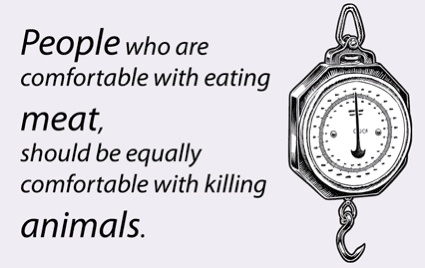 Image credit: John O’Shea
Image credit: John O’Shea
Because he is interested in the ethics and dilemmas of eating meat, John O’Shea is looking into schemes to achieve a more compassionate meat consumption. Since 2008, the artist has been working on Meat Licence Proposal. Under the law proposal, citizens willing to buy or consume a certain type of meat would need to obtain a licence to do so first. And the only way to acquire the licence is to slaughter the animal yourself.
If you happen to be in The Netherlands right now, head to Stroom in The Hague where O’Shea is showing two works related to The Meat Licence Proposal as part of the Food Forward, an exhibition presenting scenarios for the future of our food based on the work of artists and designers.
The first work in the show features the responses recorded on the streets of Manchester to The Meat Licence Proposal. The audio fragments are presented within a bespoke technological interface (developed in collaboration with artist and developer Tom Schofield) which makes connections between the recordings and actual written legal documents which support but also sometimes contradict claims that people made in response to the proposal for a new law.
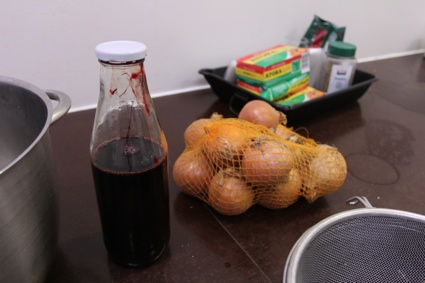 Black Market Pudding. Photo credit: John O’Shea
Black Market Pudding. Photo credit: John O’Shea
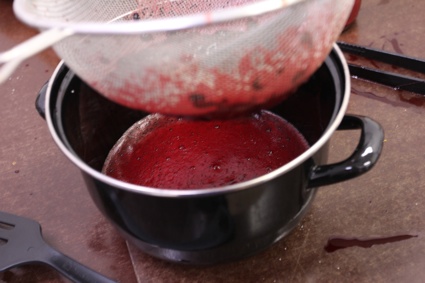 Black Market Pudding. Photo credit: John O’Shea
Black Market Pudding. Photo credit: John O’Shea
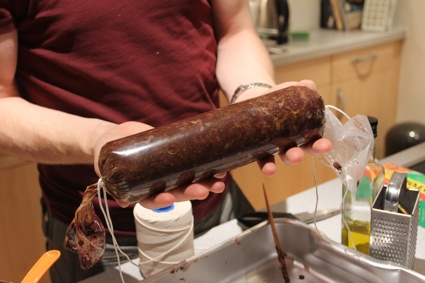 Black Market Pudding. Photo credit: John O’Shea
Black Market Pudding. Photo credit: John O’Shea
The second piece is Black Market Pudding, a real and ethically conscious food product of a new type. The project involves making the traditional blood sausage but this time using blood from a living pig. Black Market Pudding is also supported by a business plan that would ensure a fair deal for farmer, animal and consumer.
O’Shea is currently working within the Clinical Engineering department of the University of Liverpool in collaboration with Prof. John Hunt on Pigs Bladder Football , a football ball grown from living cells, for Abandon Normal Devices Festival as part of the London 2012 Cultural Olympiad.
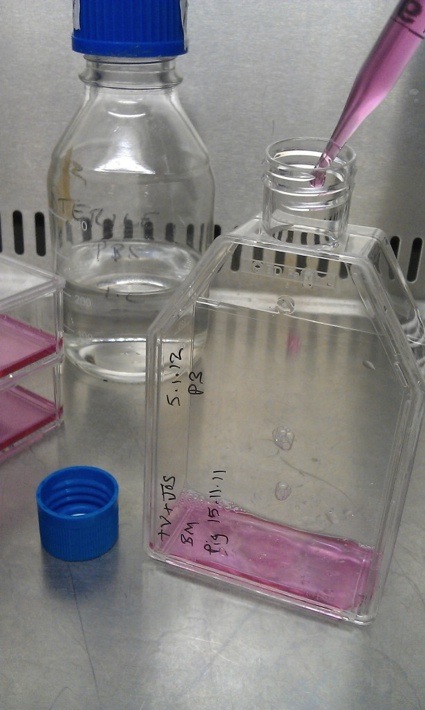 Image from the Pigs Bladder Football project
Image from the Pigs Bladder Football project
Plenty of reasons to be willing to interview John, then!
Hi John! You have been working on the Meat Licence Proposal since 2008. After 4 years developing and presenting the proposal, do you think you’re getting closer to seeing it accepted?
I can positively say that, following several consultations, dinners and public meetings, I think that many of the ethical and legal challenges for implementing a law like the one being proposed have been fleshed out.
The Meat Licence Proposal is a much more developed discourse than when it began as a web dialogue in 2008. Since then, there seems also to have been a steady increase of alternative ideas around meat consumption and production entering the mainstream consciousness in the UK, particularly through television programmes focusing on the origins of meat products and celebrity chefs advocating nose to tail approaches and so on, so I think that the cultural environment is more ripe than ever for this kind of law to work.
However, despite any small successes The Meat Licence Proposal may have had in terms of consciousness raising around apparent discrepancies between the products and processes in our food supply, I really don’t think that we are any closer to making the proposed meat licensing law an actuality for the UK. I think that I would have to take responsibility for this lack of progress in terms of actually getting the law accepted, which has mostly been down to a failure on my part to properly understand how our laws are made within our democratic society.
Fortunately, through research with Newcastle University (and the Law School there) I have begun to get a more proper understanding of the actual way in which food producers, supermarkets and other large corporations actually relate to the legal and democratic process of lawmaking around food. As I understand it now, the way things really work is pretty much the opposite to what one might expect: where The Meat Licence Proposal has started from a position of principle (people who are comfortable eating meat should be comfortable with killing animals) and attempted to extrapolate a policy from there, our actual laws and regulations around food, rather than being pro-actively constructed based upon an existing value system, are in fact developed quite subversively, in reaction to particular products and trends which emerge and are successful within the free market.
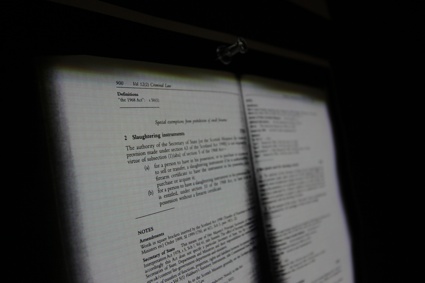 Photo credit: John O’Shea
Photo credit: John O’Shea
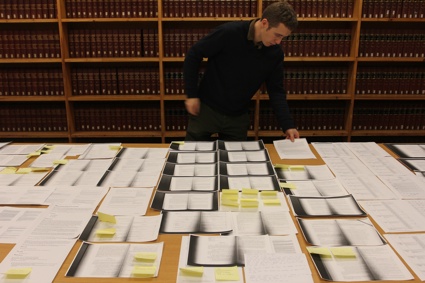 Photo credit: John O’Shea
Photo credit: John O’Shea
How have ordinary meat-eaters but also lawmakers and politicians reacted to the proposal so far? How much support/opposition has the proposal encountered?
One of the pieces on show within the Food Forward exhibition (entitled “The Meat Licence Proposal, 2012”) features a whole series of short audio pieces which are recordings of people on a Manchester High Street giving their opinion and gut-reaction to the law as it is proposed. These views vary wildly but most people seem very apprehensive about the idea that they would have to get involved with animal slaughter in order to consume meat. There is a great deal of skepticism too about how a proposed meat licencing law could work in practice; however, these logistical questions are for the most part already dealt within existing parts of UK and European law and this is what the work attempts to demonstrate, through literally using a video projector to “shed light” on over a hundred different legal statutes.
My practice is, of course, as an artist, and, to begin with I wanted to wait until the proposal had reached a reasonable level of development before approaching “professionals” and “specialists” in government and law. My justification for this quite oblique strategy is that, having been subject to innumerable laws for my whole life, I thought it would be interesting to have a go myself, on my own terms. More recently, I have been in contact with legal scholars at Newcastle University Law School and for them, The Meat Licence Proposal presents and intriguing case, since it does not operate in a way which we might expect laws to behave – it is an object of curiosity.
A few years ago I also had a brief conversation with a high ranking UK government minister about the proposal and their view was, regardless of his own opinion on it, any law which might be seen as unpopular in the short-term presents a difficult case for government (hence the very long consultation period before the inevitable implementation of UK wide bans on smoking in public places.)
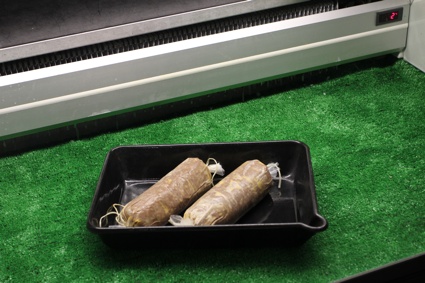 Black Market Pudding at Stroom. Photo credit: John O’Shea
Black Market Pudding at Stroom. Photo credit: John O’Shea
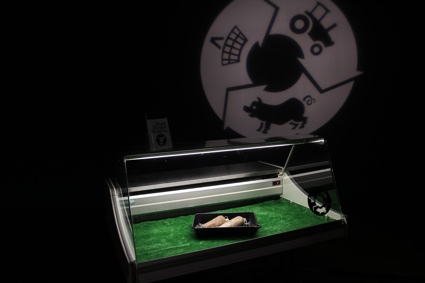 Black Market Pudding at Stroom. Photo credit: John O’Shea
Black Market Pudding at Stroom. Photo credit: John O’Shea
What was the inspiration for the proposal?
The Meat Licence Proposal in itself is not a particularly original idea – I had discussed this kind of thing many years previous with friends and it crops up sporadically on internet forums, at dinner parties and down the pub. I think the element which distinguishes this work is my decision to actively work towards making the idea for a law which would control meat into a legal reality. That strategy didn’t come from a moment of “inspiration”, as such, but like most of my work, actually emerged from a much more sustained period of anxiety around a blatant contradiction (at the time I ate meat pretty much every day, but had never killed an animal) and also the claustrophobic legal infrastructure which appeared to me to be impenetrable. I just wanted to get involved in these two parts of my daily experience and, to begin with, an activist approach seemed most appropriate.
If the proposal is enacted as law one day, how would it be put into effect? Would there be specially designed slaughter houses that anyone can enter to kill a pig and get a license? Would the killing be made following a special ritual? Using special weapons or tools? How would the law affect the distribution of meat?
These questions are very important, and I think that the suggestions you have made are probably not far off the mark. Discussions around the actual logistics of making a workable meat licencing law are still very much at the centre of this public research and development. To take the points you have made specifically: In my opinion slaughterhouses would not require very significant physical changes in how they work – instead changes would be needed at the level of policy.
At the moment you or I would typically not be permitted to enter the majority of slaughterhouses in the UK, even to see what is happening, since these are private enterprises. The right of entry is one of the first things which would have to change and I would see this as being in a similar realm to laws enabling citizens to enter courts of law and witness legal process. I think we should have similar guarantees of transparency around hidden processes in society since, at the end of the day, we are the consumer of these products and should be allowed to witness how they are made if we choose. Regarding taking part in the act of slaughter – again, there are various systems in place which allow subtle, often religious, variations on how the slaughter takes place and I think much could be drawn from existing regulation of special allowances around these methods. An illustrator, Chris Rodenhurst, with whom I have worked on several elements of how the proposal has been presented to date, produced a lovely set of sketches to suggest potential new tools for citizen slaughter. Like anything else, once this engagement with killing is happening on a national scale it will be in the hands of designers and marketers to determine exact specifications for new kinds of execution devices.
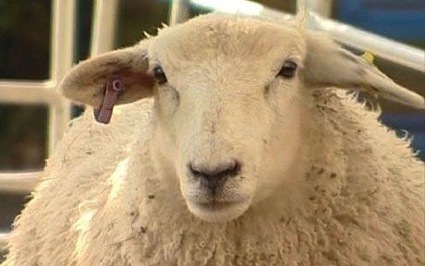 Marcus the sheep was reared by pupils of Lydd Primary School. Given the choice to keep him as a pet, or sell it for meat, the children voted by an overwhelming majority for the lamb to be sold for meat. Photo: IMAGES INTERNATIONAL
Marcus the sheep was reared by pupils of Lydd Primary School. Given the choice to keep him as a pet, or sell it for meat, the children voted by an overwhelming majority for the lamb to be sold for meat. Photo: IMAGES INTERNATIONAL
When i read about your proposal, i thought ‘great! the emotional stress of killing an animal might put people off meat’ but recalling the sad story of Marcus the sheep, i’m not so sure anymore about how much people can be moved by animals.
In your opinion, how would the law affect the way people see animals and consume meat?
Yes, I remember this Marcus the sheep story being all over the media at the time; for the “animal loving” (and mostly meat eating) British public it seemed to pose a kind of conundrum i.e: “Why has the killing of this particular animal caused such outcry?” I think the answer lies in part with the peculiar cultural and emotional distinctions made, across the world, between animals kept as “pets” and animals kept to be slaughtered for food. I think, even more important, in this case, is the act of giving the animal a (human) name which demands an identification at the level of the individual animal which would not be usual in the context of slaughter, where animals are numbered. “We are going to butcher Marcus…”
The aim of The Meat Licence Proposal is to facilitate a more coherent engagement with both animals and meat. Those people wishing to eat meat would obtain their licence by actively taking part in the slaughter of an individual animal (which would correspond to the type of meat which they would like to eat.) I think that there is a strong likelihood that some people may be put off, but this it important to keep in mind that this is certainly not a pro-vegetarian law and, surprising as it may seem, some people may find that they actually enjoy killing.
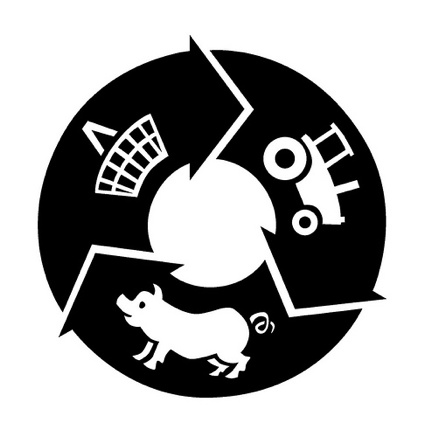 Image credit: John O’Shea
Image credit: John O’Shea
Can you tell us about the Black Market Pudding that you’re showing at Stroom in The Hague? Will it really be manufactured using blood from a living pig? The description on Stroom’s page says “In purchasing and consuming Black Market Pudding we are keeping the animal from slaughter – no animals are harmed!” How would this ensure that the animals won’t suffer?
Black Market Pudding is my own culinary invention. It is a subtle variation on the traditional black pudding which is a blood sausage dish of the UK and Ireland made using congealed pigs blood, oats and different herbs and spices. I have devised my own special recipe for what I call Black Market Pudding where, crucially, the key ingredient (pigs blood) is obtained without any animals being slaughtered; this is the unique selling point: No animals are harmed.
I worked with Stroom over several months prior to the Food Forward show to establish a supply-chain in the Netherlands in order to obtain blood from living pigs in a way which is legal, humane and safe. For the show I made several Black Market Puddings in the kitchen at the gallery, using blood from the living pigs and these are presented within a refrigerated deli-counter as “real” proof-of-concept products. An important aspect of this work is that it is not speculative or representational in a way which might be expected within a future oriented show: Black Market Pudding is already “real”.
Of course the true reality for Black Market Pudding would be for this delicacy to be for sale on the open market and this is an aim about which I have spoken at length with Karen Vershooren (curator of Food Forward). Over the course of this year I will be attempting to set up a legitimate production and sales operation for Black Market Pudding within Europe and I have made a simple website where people can register their interest. The challenges in bringing Black Market Pudding to market would be quite great I think, especially within the UK (where I am based) because it is difficult to work with animal blood in the food chain since the BSE crisis (where dried pigs blood found within animal feeds was seen to be a contributing factor). If the product were to be sold, it would be necessary that it be subjected to all of the regulations which would face any food innovation for human consumption and perhaps in this instance (where the process is different to the normal order – the animal is not killed) perhaps new laws would have to be developed for this.
I hope that Black Market Pudding can be seen as a continuation of consumer trends towards food products which contain not only their intrinsic value as foodstuffs and sources of energy but also a kind of additional ethical value which is quite difficult to quantify. If we think about the “fair trade” and “free range” labels, people are paying extra to opt out of a system which they believe to be exploitative; with Black Market Pudding I am proposing a similar business model. The name “Black Market” hints at the fact that this product operates outside of the normal order of things and the idea would be that the Black Market Puddings are sold at such a premium that, not only are you buying a delicious product, but also you are buying the animal out of the regular supply chain and ensuring it will not be slaughtered. This business model presents a fair deal for the producer (who is compensated) the animal (which gets to keep its life) and the consumer (who has this unparalleled piece of mind).
There is I suppose one caveat with Black Market Pudding and that is, by going outside of the regular carnivorous foodchain, where humans, as flesh-eaters, would consider themselves to be at the very top – here we are taking blood from an animal which is alive and so our own position in the hierarchy changes – as animals consuming the blood of another living animal we are explicitly “parasites” and so the real question for the market is whether people would be comfortable with that designation.
What are the MLP next steps?
At the very beginning of January 2012 I made a statement on the front page of The Meat Licence Proposal website explaining that there would be a change of strategy. Over the last several years I have focused my energies on a democratic approach, engaging directly with processes of law-making and suggesting that a new law could (and should) be developed in a public and transparent way, by citizens themselves, in a similar way to open-source development models which operate within software culture.
These kinds of initiatives can continue I think but it is my view now that the overall approach needs to be much more market-oriented and, once Black Market Pudding is established, I will be looking to identify more products and strategies which can close the gap between product and process (especially in meat production).
I’ll leave you now with an anonymous quote from one of the participants of a 2010 consultation exercize:
“Ultimately, The Meat Licence Proposal must engage and identify with the values of ‘the market’ where production (killing animals) is about making money, and consumption (eating meat) is about getting what we want.”
Thanks John!
The Very First Game of Pigs Bladder Football to Take Place in The 21st Century, a video by Tim Brunsden
Check out The Meat Licence Proposal at the Food Forward exhibition, Stroom, The Hague, NL. The show is curated by Karen Verschooren and remains open through April 1, 2012.
Related story: Solo exhibition of Adel Abdessemed postponed.
